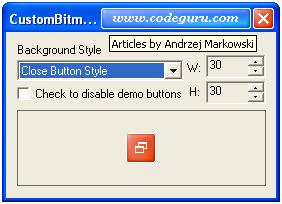Introduction
CCustomBitmapButton is MFC control derived from the CWnd class. The button has two parts: a background and a foreground. If the operating system is WinXP and XP Themes are enabled the background is a bitmap loaded from the current active theme resource file (I use similar technique to draw the scroll buttons in the CCustomTabCtrl control); otherwise, the “DrawFrameControl” function is used to draw the button background. The foreground is a user-defined monochrome bitmap (glyph) drawn transparently on the button background.
Supported features:
- Standard or XP Themes view
- 12 predefined background styles
- User-defined foregrounds (bitmap glyphs)
- Button states supported: “NORMAL”,”HOT”,”PRESSED”, and “DISABLED”
- Buttons can be created in the caption bar area
- Dialog, SDI and MDI support for the caption buttons
- Ficker-free drawing
- Built-in tooltips
Using the Code
To integrate the CCustomBitmapButton class into your application as a caption frame, please follow the steps below:
- Add ThemeUtil.h, ThemeUtil.cpp, CustomBitmapButton.h, CustomBitmapButton.cpp, Tmschema.h, and Schemadef.h to your project.
- Include CustomBitmapButton.h to the appropriate header file—usually the dialog class header where the CCustomBitmapButton class is used.
// CustomBitmapButtonDemoDlg.h : header file #include "CustomBitmapButton.h"
- Declare m_ctrlCaptionFrame object of type CCustomBitmapButton in your dialog header.
// CustomBitmapButtonDemoDlg.h : header file class CCustomBitmapButtonDemoDlg : CDialog { ...... private: CCustomBitmapButton m_ctrlCaptionFrame; }; - Create the caption frame.
In your dialog’s OnInitDialog, add the following code:
// CustomBitmapButtonDemoDlg.cpp : definition file m_ctrlCaptionFrame.CreateCaptionFrame(this,IDR_MAINFRAME);
- After creating the caption frame, add as many buttons as you need.
-
To add caption buttons, call AddCaptionButton in your dialog’s OnInitDialog:
// CustomCaptionButtonDemoDlg.cpp : definition file m_ctrlCaptionFrame.AddCaptionButton(CRect(0,0,0,0),1, CBNBKGNDSTYLE_CLOSE, FALSE); m_ctrlCaptionFrame.AddCaptionButton(CRect(0,0,150,0),2, CBNBKGNDSTYLE_CAPTION, TRUE); CCustomBitmapButton* pBn1 = m_ctrlCaptionFrame.GetCaptionButtonPtr(1); if(pBn1) { CBitmap bmpGlyph1; bmpGlyph1.LoadBitmap(IDB_GLYPH1); pBn1->SetGlyphBitmap(bmpGlyph1); pBn1->SetTooltipText(_T("Double click to close the window, Right click to display the popup menu")); } CCustomBitmapButton* pBn2 = m_ctrlCaptionFrame.GetCaptionButtonPtr(2); if(pBn2) { CBitmap bmpGlyph2; bmpGlyph2.LoadBitmap(IDB_GLYPH2); pBn2->SetGlyphBitmap(bmpGlyph2); pBn2->SetTooltipText(_T("Articles by Andrzej Markowski")); } - Process WM_NOTIFY messages from the caption buttons in your dialog class. As users click a button, the button sends notification messages (NM_CLICK, NM_RCLICK, NM_DBLCLK, and NM_RDBLCLK) to its parent window. Handle these messages if you want to do something in response.
// CustomBitmapButtonDemoDlg.cpp : definition file BEGIN_MESSAGE_MAP(CCustomBitmapButtonDemoDlg, CDialog) //{{AFX_MSG_MAP(CCustomBitmapButtonDemoDlg) ON_NOTIFY(NM_DBLCLK, 1, OnBnDblClickedCaptionbn1) ON_NOTIFY(NM_RCLICK, 1, OnBnRClickedCaptionbn1) ON_NOTIFY(NM_CLICK, 2, OnBnClickedCaptionbn2) //}}AFX_MSG_MAP END_MESSAGE_MAP() .... void CCustomBitmapButtonDemoDlg:: OnBnDblClickedCaptionbn1(NMHDR * pNotifyStruct, LRESULT * result) { CPoint pt; ::GetCursorPos(&pt); PostMessage(WM_SYSCOMMAND,SC_CLOSE,MAKEWORD(pt.x,pt.y)); } .... - Don’t forget to destroy the caption frame; otherwise, you will have memory leaks.
// CustomBitmapButtonDemoDlg.cpp : definition file void CCustomBitmapButtonDemoDlg::OnDestroy() { m_ctrlCaptionFrame.DestroyCaptionFrame(); CDialog::OnDestroy(); }


